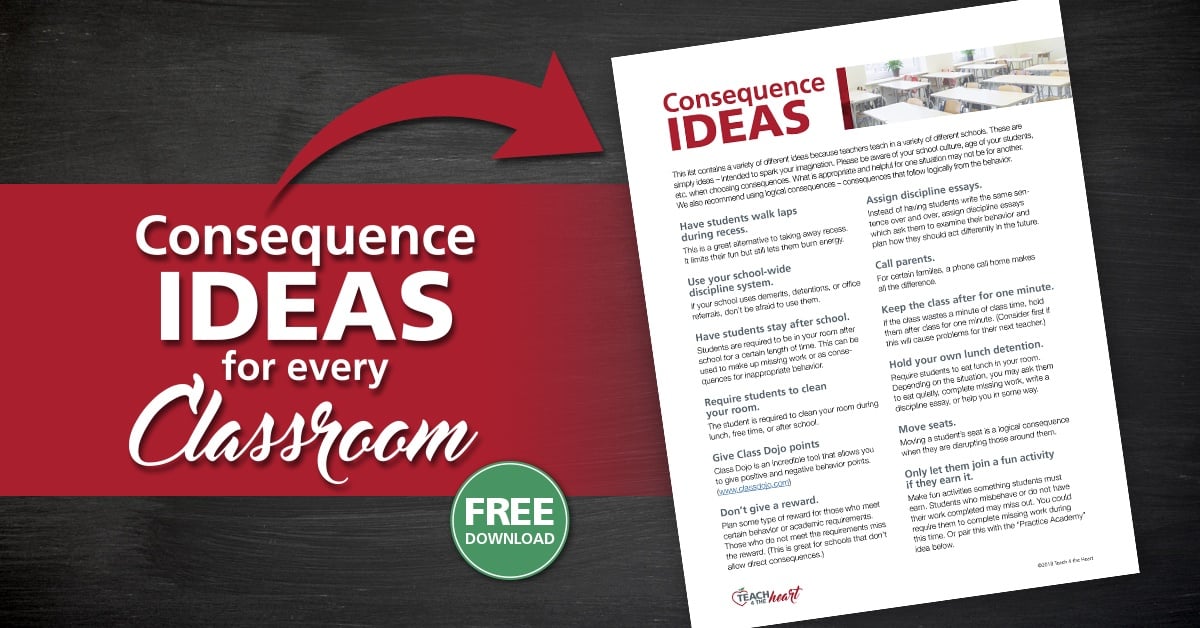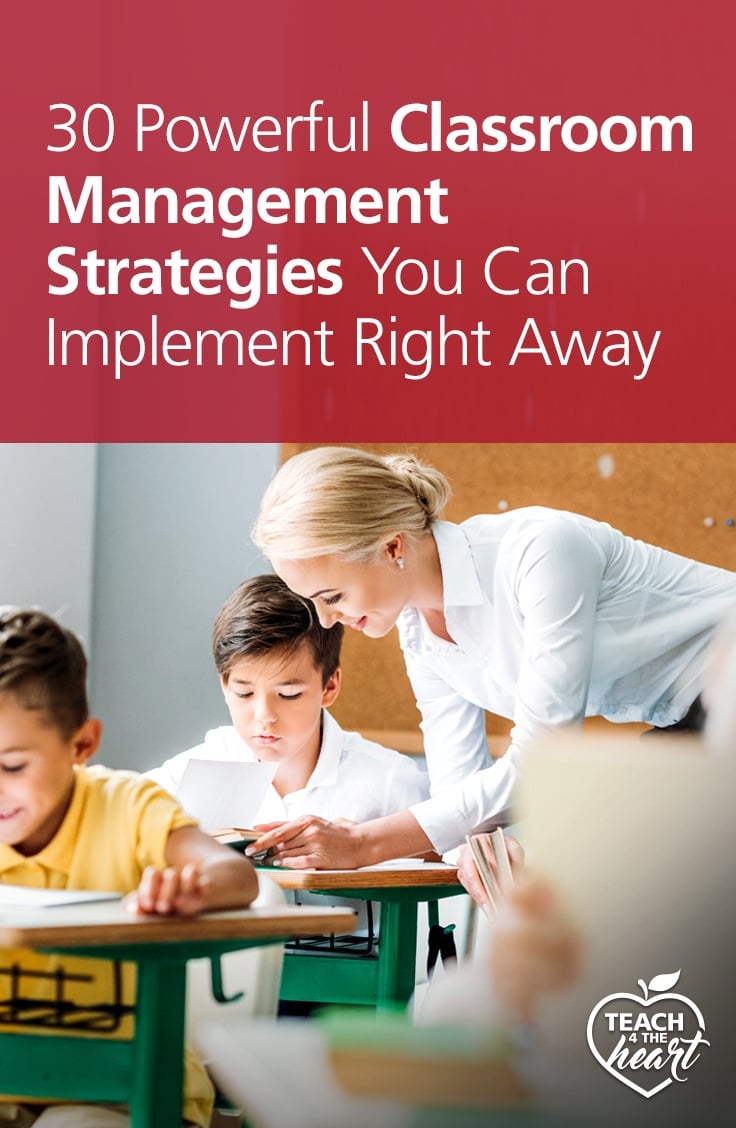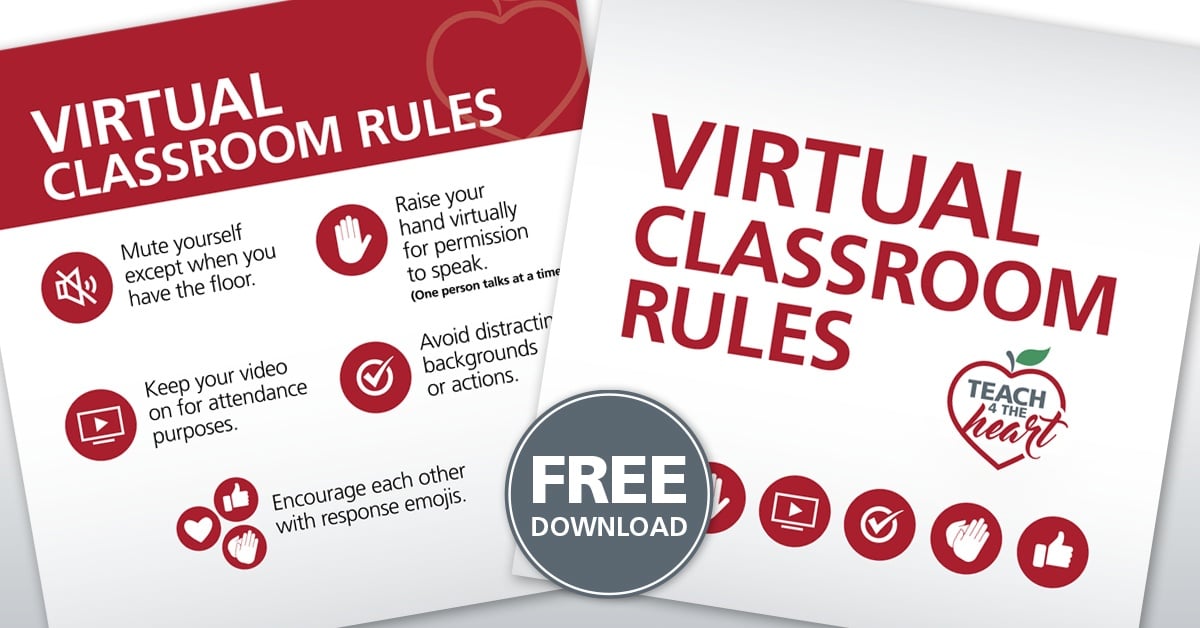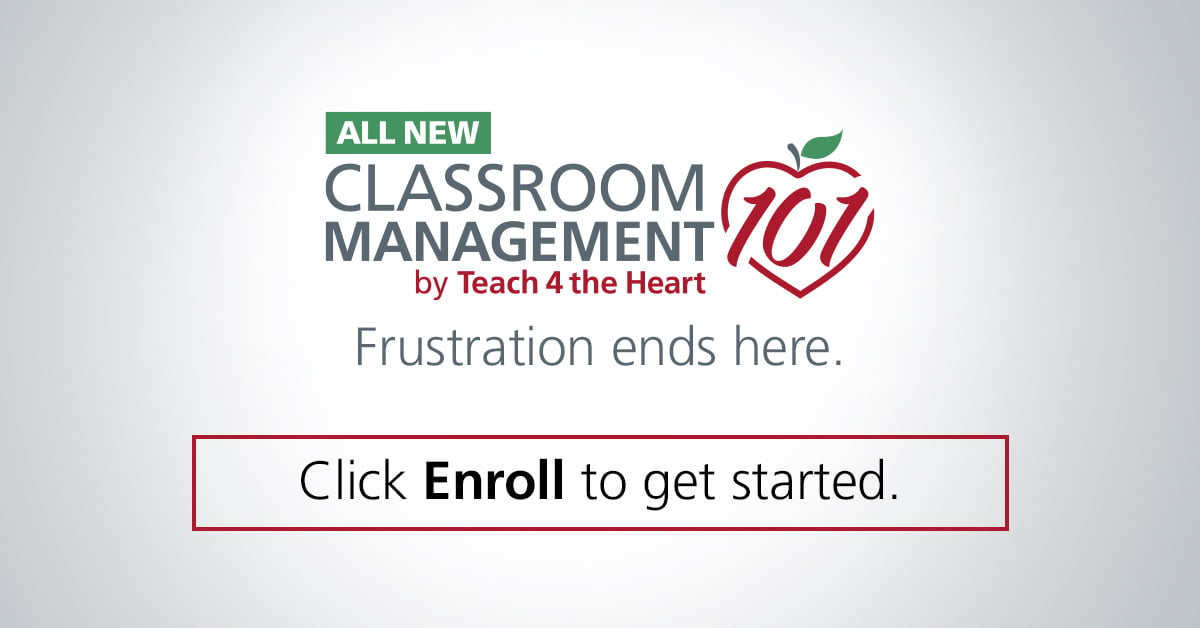
Looking for some tried and true classroom management strategies that will actually work in your classroom? Look no further. They're all here.
Classroom management was a huge struggle for me when I first started teaching. Okay, struggle is putting it a bit nicely. It may or may not have escalated to the point that I found myself crying in the back hallway because I just couldn’t face my first period class.
But thankfully that’s not the end of the story. With the help of amazing mentors The First Days of School, consistent practice, and a huge dose of God’s grace, I finally found some classroom management strategies that actually worked and eventually turned things around.
And, oh what a joy to finally get to the point where my class was (for the most part) controlled, focused, on task, and learning effectively!
I was teaching, my students were learning, and it was amazing.
That’s where you want to be, too, right? I mean, none of us got into teaching because we couldn’t wait to deal with classroom management issues! We want to actually teach. To see those light bulbs go off. To make a difference.
But in order for that to happen, we have to create a conducive learning environment, and that requires a strong foundation of great classroom management techniques.
In this post, I’m compiling all of my best classroom management strategies with links to explore each in more detail. I hope they’ll be helpful for you!
Ready to dive in? Here's some of the topics we'll be covering in this article:
Classroom management strategies to
DEVELOP THE RIGHT DEMEANOR
To be an effective teacher (and be any good at classroom management), you have to have the right demeanor. That boils down to a few main things:
1. Be both kind and firm.
Don’t get fooled into thinking you have to choose between being nice or being strict. You can be both, and I’d argue you must be both.
Go deeper: What to Do If You’re Told You’re Being Too Nice
2. Focus on being respected rather than being liked.
We all want our students to like us, but if we make that our goal, we’re going to run into some serious classroom management problems. Instead, focus on earning your students’ respect and creating a learning environment where they can learn and grow.
Go deeper: If You want Your Students to Like You
3. See yourself as your students’ mentor, not their friend.
We all want to be there for our students, support them through challenges, and make a real difference in their lives. But if you think that being their friend is the way to get there, you’re going to create more problems than you solve. Instead, view yourself as your students’ mentor. This means you’re there to help, support, and guide them, but there’s clear respect, not a peer-to-peer relationship.
Classroom management techniques to
PUT TOGETHER A GOOD PLAN
If you’re struggling to keep control, one of the biggest mistakes you can make is to walk into class without a plan for how you’re going to deal with everyday problems like off-task talking, blurting, disrespect, etc. Believe me, I know from all-too-sad experience the disaster that will befall. You’ve got to have a plan. And here’s a few ideas for how to create one:
1. Plan your rules and expecations
You need to first get clear on what your rules and expectations are. How do you expect students to behave in various situations? Whether you decide this on your own or work with your class to develop rules, the key is that they are clearly communicated and that there's no confusion about what you expect from your students.
If you're teaching online, here's a list of virtual classroom rules you can download & share with your students:
Get the Virtual Classroom Rules list.
2. Use a warning system.
When it came to curbing distractions like talking and blurting, a warning system was a huge help for me. The way it works is that you give individual warnings to students whenever they are talking without permission. The warning holds no consequences – it’s just a warning. But it helps students notice they’re being disruptive and (hopefully) self-correct. Nine times out of ten, that’s all that’s needed. However, if students do persist in being disruptive after receiving a warning(s), then you need to give a pre-determined consequence.
Get the details: I explain how I used a warning system to control my disruptive class here.
And if you’re wondering if a warning system/behavior chart is such a good idea, I tackle that question here: Should I use a Behavior Chart?
3. Try Whole Brain Teaching
Amongst many other fabulous ideas, Whole Brain Teaching uses call-and-response sayings to 1) regain students' attention and 2) reinforce correct behavior. So, for example, if a student blurts out an answer, you call out “Remember, Rule 2” and your class responds with “Rule 2: Raise your hand for permission to speak.” Obviously, this requires a lot of teaching/training up front, but if this fits your style it would totally be worth it!
Find out more here: Read more about Whole Brain Teaching classroom management strategies
4. Plan wise consequences.
Consequences should only be one small part of your classroom management plan, but they do play an important role. The key is to choose wise consequences that make sense and are a good fit for your students & the culture of your school.
Click here to download a list of consequence ideas.

If you’d like more help putting together your plan, consider joining us in Classroom Management 101. In this self-paced online course, we’ll walk you step-by-step through the process of developing and then implementing a strong classroom management plan.
behavior management strategies to
EXECUTE YOUR PLAN
Once you have your plan ready, it’s time to put it in place. But it’s not enough to simply say “okay, this is what we’re going to do.” Here’s some ideas for what to do instead:
1. Conduct a classroom shake-up.
If you’re trying to turn things around mid-year, use a classroom shake-up to force a bit of a reset. In a classroom shake-up, you change something in your classroom – whether it’s switching up a routine or physically changing something in the room. The purpose is to grab your students’ attention and get them to ask what’s going on – to show not just tell them that things will be different. Then, you can explain the new procedure/expectation.
Find out more: How a Shake-Up Can Revolutionize Your Classroom Management Plan.
2. Teach and practice procedures.
Teaching strong procedures is one of the most important classroom management strategies ever. It’s not enough to simply tell students what to do. You have to invest the time into training and practicing. I recommend a 4-part process for teaching procedures: explain, practice, correct, and redo. I explain all four parts in this article here: How to Teach Procedures that Your Students Will Actually Follow.
Classroom management strategies to
DEAL WITH PROBLEMS THAT ARISE
Executing your new classroom management plan is not going to magically solve all your problems. You also need to be ready to deal with the issues when they arise. Here’s some strategies to help you do that:
1. Deal with problems while they’re small.
The advice “don’t sweat the small stuff” has its place, but it certainly does not work when you’re trying to start the school year right, reset your classroom, or teach a new procedure. I wish we could let the little things go, but, honestly, if you do, the little problems don’t stay little. They grow into bigger and bigger problems. (Believe me. I’ve learned this lesson the hard way, too.)
Instead, be looking for the first problem and deal with it right away. That doesn’t mean you lambast the kid or slap him with a detention for saying one word. But it does mean that you kindly address the issue – every time. It could be as simple as reminding them of the correct procedure and asking them to redo it. As you consistently deal with the small problems, students will see that you actually mean what you say and will get used to following class guidelines.
Go deeper: Read more about the why we need to deal with problems while they’re still small.
2. Be consistent.
It is so hard to be consistent, but consistency is a huge key to classroom management success. Simply decide what you are going to do and then do it. Consistently. And if you miss one time, don’t let that derail you. Determine to get back on track the next opportunity you get.
Read more: How to Be More Consistent in Your Classroom Management
3. Know when to give grace.
As important as consistency is, sometimes we need to break from our plan and give a student some grace. The question is – how do we know when to stick to our classroom management plan and when to give grace? Well, the key is to always do what’s best for the student, not what’s easiest for us. We talk more about it in the article below:
Go deeper: 4 Questions to Know When to Give Grace as a Teacher
We tackle in-depth how to handle various classroom problems from chatter and blurting to outright disrespect to class clowns in Classroom Management 101. Find out more about the complete classroom management course here.
Classroom management techniques to
PREVENT PROBLEMS
When we think of classroom management, we often look for strategies that help us solve problems. But the truth is that the best classroom managers are actually tremendously good at preventing problems from happening in the first place. It’s the key to their success.
A lot of the classroom management strategies above will help you prevent problems, but here’s some more that you don’t want to miss:
1. Build rapport.
Strong relationships are key to classroom management success. So invest time into getting to know your students and building rapport with them. Be particularly aware of things that can harm your rapport. I share some of them in this tongue-in-cheek article here: 7 Easy Ways to Destroy Your Rapport with Your Students
2. Have students clear their desks.
Rather than allowing students to hide behind a huge pile of books and notebooks on their desk, require them to have out only what they need for the current activity. Everything else should go inside their desk or under their chair. This simple procedure will not only eliminate distractions and help your students focus, but it will also make it easier for you to see what’s happening in your class.
Read more: A Super Simple Way to Help Students Focus
3. Keep your students engaged.
The more engaged your students are in learning, the less they will cause problems. So let your passion for teaching show and make your subject come alive. Also, remember that the one who is working is the one who is learning, so don’t just lecture all day. Get your students involved.
So how exactly do you do this? This topic is so important that we’re giving it its own section in this article.
Jump to it here: Classroom Management Strategies to Engage Your Students
4. Be organized.
Disorganization leads to lulls in your class, which lead to kids getting bored and misbehaving. Plan your lessons well, have your supplies ready, and be as organized as possible. Think right now about what items you seem to be constantly displacing and figure out a system to help you keep track of them.
We’ll go into specific organizational strategies later in this article.
Jump to that section here: Classroom Management Strategies to Help You Be More Organized
5. Dress professionally.
Whether we like it or not, how we dress makes a difference in how our students perceive us. How professional we need to dress, however, depends on a variety of factors. We go into them in this article here: Do Teachers Really Need to Dress Professionally?
You may also find helpful: How to Dress Professionally on a Teacher’s Income
6. Move around the classroom.
Don’t be stuck at the front of the room. Feel free to walk around as you teach. Not only does this provide some variety, but it also helps you keep a better eye on what the students are doing. Does it look like Greg may be texting? Walk back towards his desk for a closer look without interrupting class.
7. Prevent cheating.
Don’t be naïve and think your students won’t cheat. But don’t jadedly throw your hands up and assume they will either. Instead, do what you can to prevent cheating and create an environment of academic integrity.
Find specific strategies for how to prevent cheating here: 8 Ways to Prevent Cheating
classroom management ideas to
ENGAGE STUDENTS & EARN BUY-IN
You can try to force your students to listen and learn, but you’ll be so much more effective if you can grab their attention with engaging lessons that make them want to learn. Here’s some strategies to help you do just that:
1. Give students more choices.
One way to empower students is to give them more choices, but that shouldn’t mean that we abdicate control. Instead, find ways to let students choose between two-three options that are all good choices. I explain this concept and give a bunch of examples here: 20 Student Choice Ideas that Share Control without Losing It
2. Replace worksheets with engaging activities.
Worksheets can be a beneficial practice tool, but if we can find a way to make the practice more engaging, our students are going to be more focused and on-task (and thus causing fewer problems).
Here’s 7 ideas for how to turn your existing worksheets into engaging activities.
3. Add movement.
Getting your students moving can help in a variety of ways. Not only does it release some of that pent-up energy, but it can also help students learn and retain information better as they make mind-body connections.
Find out more: 3 Way to Add Movement to Your Classroom
4. Get to know your students.
The better you understand your students, the more you’ll be able to engage them – and the better you can help them address challenges or issues that arise.
Use this list to help you get to know them better: 20 Questions to Help You Get to Know Your Students
5. Show your students you love them.
You wouldn’t be a teacher if you didn’t care about your students, but do your students know you love them? We have to show them that we care, and here’s some ways to do that: How to Show Real Love for Your Students
6. Build relationships with your most challenging students.
The kid that challenges your patience the most is the one you need to spend the most time developing a relationship with. And it doesn’t have to be complicated. Here are some ideas: 6 Ways to Build Rapport with Struggling Students
7. Guide students to solve their own problems.
When we try to solve all our students’ problems for them, the not-so-subtle message they receive is that they aren’t capable of dealing with them on their own. But when we instead empower them to solve their own problems, we unlock a world of possibilities and release their incredible potential.
If you want to create a classroom culture where your students are engaged and focused, consider joining us in Classroom Management 101 In this course, you’ll discover how to get you & your students to be on the same team, working together to release their incredible potential and accomplish great things.
Find out more about Classroom Management 101 here.
behavior management strategies to
TROUBLESHOOT CHALLENGES
A list of classroom management strategies could never be complete without addressing some of the common challenges we face as teachers. Here we go…
1. Start class off right.
The start of class sets the tone, so don’t let the chaos enter your classroom. Instead, teach your students strong start-of-class procedures, including an activity to do when they arrive. If you do this right, your students should be able to start class by themselves, even when you’re not there.
Find out more: How to Start Class without the Chaos
2. Keep noise down during independent work times.
For your classroom to run smoothly, students need to learn how to work well independently, and that includes keeping the noise level down so that the rest of the class can concentrate. Here’s some tips for how to do just that: How to Keep the Noise Level Down During Independent Work Times
3. Create smooth transitions.
Transitions can be such a chaotic time, but they don’t have to be. Get specific tips for how to create smooth classroom transitions here: 7 Tips to Reduce Chaos During Classroom Transitions
4. Don’t let complaining derail you.
When you try to rein things in, students are most likely going to complain and argue. But that doesn’t mean you should give up – or give in. Check out these strategies for handling students’ complaints and not-so-sincere questions (lessons I, unfortunately, had to learn the hard way).
5. Reduce arguments.
I remember the day I discovered four magic words that drastically reduced the arguing and back-talk in my class. And those words were: “You’re not in trouble.” Seriously magic. The other key: don’t argue. Ever. (We talk more about this in Classroom Management 101)
Find out more: 4 Magic Words that Will Cut Arguments in Half.
6. Hold students responsible for class work.
Do you have students who just don’t do their work? Obviously that creates a plethora of problems. So what do you do? Check out these 17 ideas to get students to actually do their work.
7. Don’t accuse when you don’t know.
If you suspect a student has done something but aren’t quite sure, that is not the time to lock horns in battle. My former principal called this “charging a gray hill,” as it often results in casualties over something that’s no-so-certain and almost certainly not worth it.
So what do you do instead? Speak truth to the student but reserve any punishment. Then watch and see if it happens again. I explain this more in the article below:
Find out more: What to Do When You Suspect a Student (but can’t be sure)
8. Wisely handle defiance.
A defiant student can totally disrupt your entire classroom. And navigating the situation is tricky – as you have responsibilities both to the student himself and to the rest of the class. Here’s some ideas for how to stop defiance in your classroom.
9. Crush it with a large-sized class.
A supersized class can be scary, but it doesn’t mean you can’t have a great year. The key is to be extra consistent, structured, and focused. And if you do it right, you’ll be able to have lots of fun, too.
Find out more: Classroom Management Strategies with a Supersized Class
Classroom management techniques to
BE ORGANIZED
Organization plays a huge role in successful classroom management. Mostly because if you’re not organized, you get flustered, add chaos to your classroom, and create lulls that students have to fill with something (and we all know that something is typically not so good). So, here are some classroom management strategies to help you be more organized:
1. Set up your classroom wisely.
It’s easy to spend so much time creating a beautiful classroom that you end up dropping the ball on its actual functionality. Check out these important tips for setting up your classroom: Setting Up Your Classroom: 9 Practical Things You May Not Have Thought Of
2. Have a system to keep track of missing work.
Keeping track of who has and hasn’t turned in what can be a nightmare – but not if you have a good system. Here’s some tips to help you track your missing work: Simple Solutions to Track Missing Work
3. Delegate responsibility with meaningful classroom jobs .
Your classroom will run more smoothly if you’re not trying to do everything yourself. So get your students involved by delegating more responsibility to them. Ask yourself, “What am I currently doing that my students could do instead?” We go into detail about how to give students meaningful classroom jobs here.
I hope you’ve found these classroom management strategies helpful, but the truth is that classroom management is nuanced. Unfortunately, one missing element can throw everything off and frustrate your best intentions.
That’s why we’ve created Classroom Management 101 – the complete, organized system that ensures you don’t miss any of the crucial elements necessary for successful classroom management. We’d love to have you! You can get all the details here:
spread the word!
Did you find this post helpful? Clue in your fellow teachers by sharing the post directly (just copy the URL) or by clicking one of the buttons to automatically share on social media.

This post may contain affiliate links. This means that if you purchase a resource/product after clicking the link, Teach 4 the Heart will receive a small commission at no extra cost to you. Thanks for helping support Teach 4 the Heart in this way.






You are doing an amazing job. I was inspired by the 30 powerful classroom management strategy.
A good write -up
Thank you very much for sharing your experiences and expertise.
You have some great ideas to implement. I saved a few to read later. Classroom management (especially student behavior is probably the most important part of running a classroom. If you don’t have control, there won’t be much learning going on. Thanks for the encouragement!
This is an awesome article. Packed full of help!
Nice one